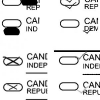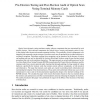11 search results - page 1 / 3 » Mark Detection from Scanned Ballots |
DRR
2009
13 years 8 months ago
2009
Analyzing paper-based election ballots requires finding all marks added to the base ballot. The position, size, shape, rotation and shade of these marks are not known a priori. Sc...
WOTE
2010
13 years 9 months ago
2010
Optical mark-sense scanning has lead to a resurgence in the use of paper ballots in the United States, despite a century of strong competition from paperless direct-recording votin...
ICPR
2008
IEEE
15 years 3 days ago
2008
IEEE
Optical mark sensing, i.e., detecting whether a "bubble" has been filled in, may seem straightforward. However, on US election ballots the shape, intensity, size and pos...
USS
2008
14 years 1 months ago
2008
We introduce Scantegrity II, a practical enhancement for optical scan voting systems that achieves increased election integrity through the novel use of confirmation codes printed...
USS
2008
14 years 1 months ago
2008
Optical scan electronic voting machines employ software components that are customized for each specific election. Such software components are critical from a security and integr...


